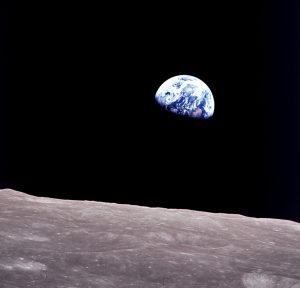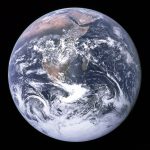
![]() In 1950, astronomer Fred Hoyle predicted that a photograph of the whole Earth would unleash a new idea as powerful as any in history. On Christmas Eve, 1968, the crew of Apollo 8 finished its fourth orbit around the moon. As they emerged from the moon’s dark side, they saw the Earth rise before them. Astronaut William Anders remembered the sight of “…a very fragile looking Earth, a very delicate looking Earth, I was immediately almost overcome by the thought that here we came all this way to the Moon, and yet the most significant thing we’re seeing is our own home planet, the Earth.”[footnote]Robert Poole, Earthrise (New Haven and London: Yale University Press, 2009), p. 2.[/footnote] The astronauts reached for their cameras.
In 1950, astronomer Fred Hoyle predicted that a photograph of the whole Earth would unleash a new idea as powerful as any in history. On Christmas Eve, 1968, the crew of Apollo 8 finished its fourth orbit around the moon. As they emerged from the moon’s dark side, they saw the Earth rise before them. Astronaut William Anders remembered the sight of “…a very fragile looking Earth, a very delicate looking Earth, I was immediately almost overcome by the thought that here we came all this way to the Moon, and yet the most significant thing we’re seeing is our own home planet, the Earth.”[footnote]Robert Poole, Earthrise (New Haven and London: Yale University Press, 2009), p. 2.[/footnote] The astronauts reached for their cameras.
The next day, poet Archibald MacLeish in his front page New York Times essay, “Riders on the Earth,” reflected on the profound impact of the sight. MacLeish wrote, “To see the earth as it truly is, small and blue and beautiful in that eternal silence where it floats, is to see ourselves as riders on the earth together, brothers on that bright loveliness in the eternal cold – brothers who know now they are truly brothers.”[footnote]Archibald MacLeish, “A Reflection: Riders on the Earth Together, Brothers in Eternal Cold,” The New York Times, December 25, 1968, p. 1.[/footnote]
In subsequent years, the photograph of the Earth rising over the surface of the moon taken by Anders would be one of the most indelible images to emerge from the Apollo program; as writer Norman Cousins told members of Congress in 1975: “what was most significant about the lunar voyage was not that men set foot on the Moon, but that they set eye on the Earth.”[footnote]William Irwin Thompson, “The deeper meaning of Apollo 17,” New York Times, January 1, 1973, p. 13.[/footnote]

With the photograph came a new reverence for the environment. As Robert Poole, author of the fascinating book Earthrise, writes, “Looking back, it is possible to see that Earthrise marked the tipping point, the moment when a sense of the space age flipped from what it meant for space to what it meant for Earth.”[footnote]Robert Poole, Earthrise (New Haven and London: Yale University Press, 2009), p. 8.[/footnote] Fifteen months after the photograph was taken, the first Earth Day was celebrated. Four years after Apollo 8, members of the last Apollo mission brought back a photograph that was to be even more famous: the iconic “blue marble” view of the entire earth, an image that has been called the most influential environmental photograph ever taken.
While colonies in space were thought of as a way out of nuclear holocaust during the Space Race, today some propose them as a final resort to the inevitable environmental destruction of the Earth. As scientists and activists predict the decline of the planet, will our attention turn from the Earth to other planetary systems?